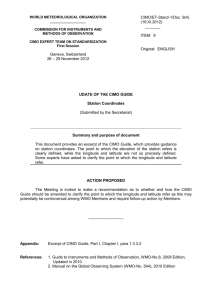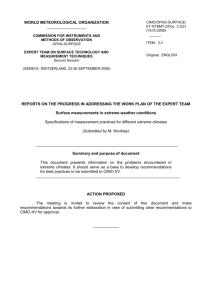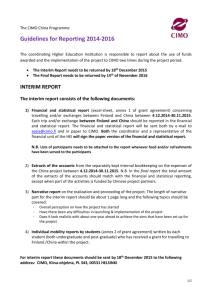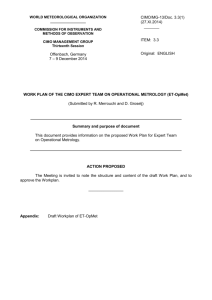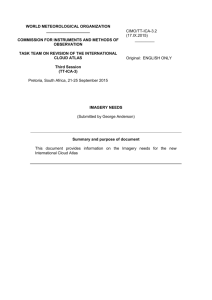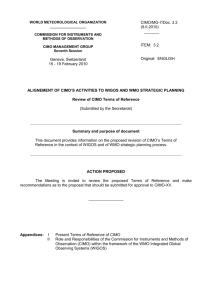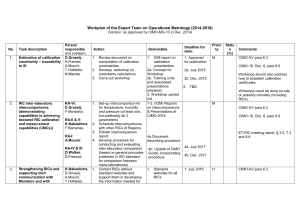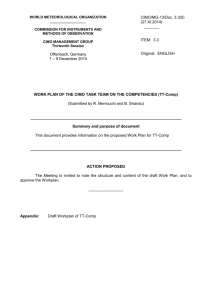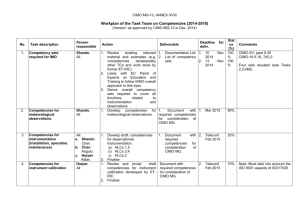CIMO/MG-1/Doc.2.2
advertisement
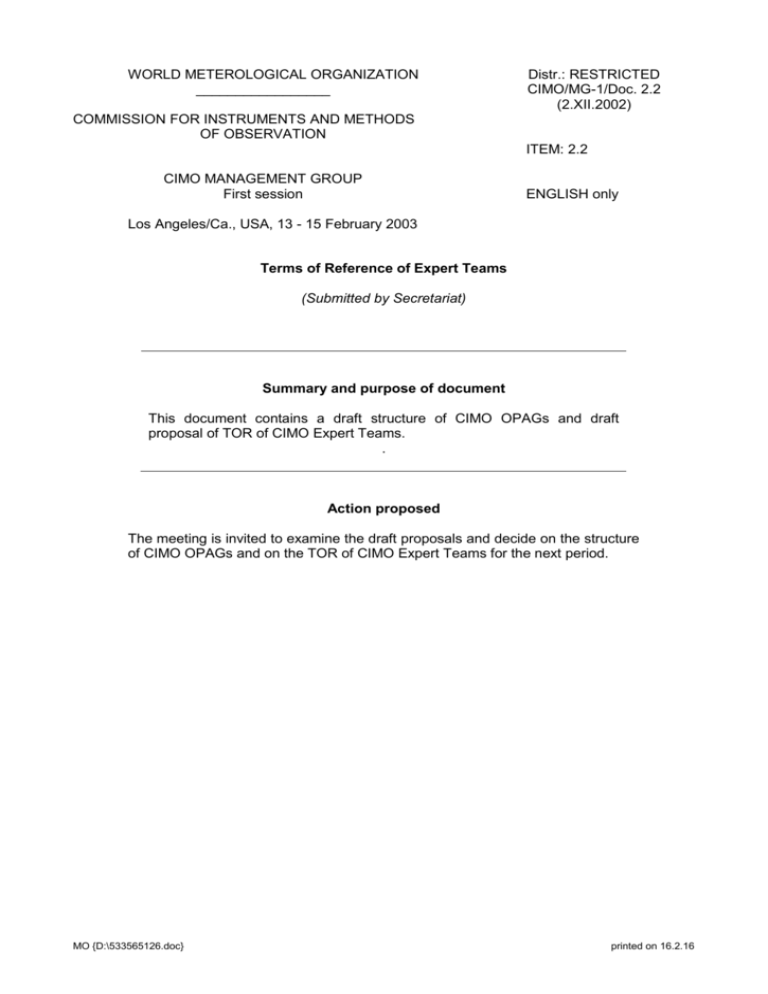
WORLD METEROLOGICAL ORGANIZATION
_________________
Distr.: RESTRICTED
CIMO/MG-1/Doc. 2.2
(2.XII.2002)
COMMISSION FOR INSTRUMENTS AND METHODS
OF OBSERVATION
ITEM: 2.2
CIMO MANAGEMENT GROUP
First session
ENGLISH only
Los Angeles/Ca., USA, 13 - 15 February 2003
Terms of Reference of Expert Teams
(Submitted by Secretariat)
Summary and purpose of document
This document contains a draft structure of CIMO OPAGs and draft
proposal of TOR of CIMO Expert Teams.
.
Action proposed
The meeting is invited to examine the draft proposals and decide on the structure
of CIMO OPAGs and on the TOR of CIMO Expert Teams for the next period.
MO {D:\533565126.doc}
printed on 16.2.16
CIMO/MG-1/Doc. 2.2, Appendix A
Background Information
1. The thirteenth session of the Commission for Instruments and Methods of Observation
requested the CIMO Management Group (CIMO-MG) to "Keep under review the internal structure
of the Commission and make adjustment, as necessary" and to "Keep under review the Terms of
Reference (TOR) of Expert Teams and make necessary adjustment".
2. Based on revised tasks to be undertaken of the CIMO OPAGs (Doc.2.1) a draft structure of
CIMO OPAGs and corresponding TOR of CIMO Expert teams are presented in Appendix B and
Appendix C, respectively.
MO {D:\533565126.doc}
printed on 16.2.16
CIMO/MG-1/Doc. 2.2, Appendix B
STRUCTURE OF CIMO OPAGs
(Draft Proposal)
A.
OPAG-SURFACE
A.1
B.
Expert Team on Surface Technology and Measurement Techniques
A.1.1
Rapporteur on Urban Meteorological Measurements
A.1.2
Rapporteur on Road Meteorological Measurements
A.2
Expert Team on Surface-based Instrument intercomparisons and Calibration
Methods
A.3
Expert Team on Meteorological Radiation Measurements
OPAG-UPPER AIR
B.1
Expert Team on Upgrading the Global Radiosonde Network
B.1.1 Rapporteur on Integrated Observing Systems
B.1.2 Rapporteur on Radiofrequency Issues
B.2
Expert Team on Upper-air System Intercomparisons
B.3
Expert Team on Remote Upper-air Technology and Techniques
B.3.1 Rapporteur on Lightning Detection Systems
C.
OPAG-CAPACITY BUILDING
C.1
Expert Team on Training Activities
C.2
Expert Team on Quality Management Systems Procedures
C.3
Expert Team on Development Guidance and Training Materials
C.4
Expert Team on Developing IMOP Capacities and on Technical Assistance
MO {D:\533565126.doc}
printed on 16.2.16
CIMO/MG-1/Doc. 2.2, Appendix C
TERMS OF REFERENCE OF CIMO EXPERT TEAMS
(Draft Proposal)
A.
OPAG-SURFACE
A.1
Expert Team on Surface Technology and Measurement Techniques
1.
Report and recommend methods for automated visual and subjective
observations, with emphasis on:
(a)
Systems measuring present weather (including clouds, icing, state of the
ground, lightning and thunderstorms);
(b)
Standardization of algorithms for AWSs, (CIMO-XIII/4.1.7).
2.
Agree on standards for automation of manual, visual and subjective observations,
(CIMO-XIII/11.7).
3.
Provide guidance on the state-of-the-art of instruments and Automated Surface
Observing Systems (ASOS), in particular on:
(a)
Development and implementation of instruments and ASOS;
(b)
Instrument and ASOS
environmental conditions;
implementation
and
siting
in
varying
4.
Review the table on Operational Accuracy Requirements and Typical Instrument
Performance, (CIMO-XIII/4.1.12);
5.
Update relevant WMO practices/guidelines and develop guidance on metadata
requirements.
A.1.1
Rapporteur on Urban Meteorological Measurements
A.1.2
6.
Report on progress of urban meteorological measurements;
7.
Monitor the emerging requirements for measurements and develop
pertinent technical recommendations for standards and practices to be
included in the CIMO Guide.
Rapporteur on Road Meteorological Measurements
8.
Report on progress of road meteorological measurements;
9.
Monitor the emerging requirements for measurements;
10.
Explore further difference in perception of WMO standards for synoptic
stations at road meteorological observing stations, especially in the light
of the requirements of modern road monitoring and traffic management
systems, (CIMO-XIII/4.6.3);
11.
Develop pertinent technical recommendations for standards and
practices to be included in the CIMO Guide.
MO {D:\533565126.doc}
printed on 16.2.16
CIMO/MG-1/Doc. 2.2, Appendix C, p.2
A.2
Expert Team on Surface-based Instrument Intercomparisons and Calibration
Methods
1.
A.3
Organize and evaluate WMO instrument intercomparisons:
(a)
IPC-X, 2005, WRC, Switzerland, (CIMO-XIII/8.9);
(b)
RPCs, 2004-2006, either in conjunction with IPC-X or at RPCs
concerned, (CIMO-XIII/8.9);
(c)
Rainfall Intensity gauges, 2003, in various climatic regions, (CIMOXIII/8.9);
(d)
Thermometer screens/shields, 2003-2005, in various climatic regions,
(CIMO-XIII/8.9);
(e)
Hygrometers, 2003-2005, in various climatic regions, (CIMO-XIII/8.9);
(f)
Intercomparison of spectral radiometers (used for aerosol optical depth
determination) from the Regional Radiation Centres (in tandem with
IPC-X), (CIMO-XIII/5.5.6);
(g)
A combined CAS/GAW and CIMO intercomparison UV measurement
instruments (spectrometers, broadband instruments and filter
instruments), (CIMO-XIII/5.6.7).
2.
Prepare proposals for other instrument intercomparisons:
3.
Review advances in calibration methods.
Expert Team on Meteorological Radiation Measurements
1.
Liaise with the World Climate Research Programme on matters related to
Baseline Surface Radiation Network and inform Members of developments;
2.
Review the operational practice associated with total ozone measurements.
Prepare recommendations for a standard automated ozone observational site;
3.
Review the operational practice associated with UV and, aerosol optical depth
measurements;
4.
Monitor the efforts of the CAS Scientific Steering Committee on UV
Measurements and use the relevant reports, when available, as the basis for
updating Chapter 7, "Measurement of radiation", of Part I of the CIMO Guide,
(CIMO-XIII/5.6.2);
5.
Develop further the establishment of a World Standard Group of absolute longwave radiometers, (CIMO-XIII/4.5.8);
6.
Coordinate the dissemination of World Radiometric Reference (WRR) factors to
regional and national radiation standards, (CIMO-XIII/4.5.9);
7.
Initiate activities so that high quality solar radiation measurements may be widely
guaranteed in all national radiation networks, and support on request the National
Radiation Centers (NRCs) through training courses and in the establishment of
networks in areas with a low density of radiation stations, such as in RA I,
MO {D:\533565126.doc}
printed on 16.2.16
CIMO/MG-1/Doc. 2.2, Appendix C, p.3
(CIMO-XIII/4.5.9);
8.
Provide technical/scientific guidance in the establishment and continuing quality
assurance of WIRCC Davos, (CIMO-XIII/4.5.14).
B.
OPAG-UPPER AIR
B.1
Expert Team on Upgrading the Global Radiosonde Network
1.
Improve the global radiosonde network through:
(a)
Development of techniques and annual reports on the performance of
radiosonde types in the GOS;
(b)
Soliciting agreement on BUFR code table and descriptors for
international use (1-2 years);
(c)
Dealing with the technical issues involved in modernizing and improving
the accuracy of the radiosonde component of the upper-air network, e.g.,
working reference for future radiosonde comparisons, (CIMOXIII/5.1.14).
2.
Review the existing data processing algorithms for radiosondes and recommend
on a global standard.
3.
Review the error characteristics of water vapour measurements and explore
compatibility between the different types of measurement:
4.
Prepare guidance material on developing GPS water vapour networks;
5.
Monitor and assist in the introduction of humidity measurements in AMDAR
systems.
B.1.1
Rapporteur on Integrated Observing Systems
B.1.2
6.
Promote, facilitate and assist with developments in integrated observing
systems;
7.
Monitor the progress of projects set up to integrate different groundbased observing techniques together to provide improved sensing of
vertical profiles of temperature, humidity and cloud structure, (CIMOXIII/5.1.29).
Rapporteur on Radiofrequency Issues
8.
Continue radiofrequency allocation studies for ground based observing
systems;
9.
Improve coordination of radiosonde operating frequencies between
neighboring countries;
10.
Assist in coordination and protection of radiofrequencies for groundbased observing systems, (CIMO-XIII/5.1.12).
MO {D:\533565126.doc}
printed on 16.2.16
CIMO/MG-1/Doc. 2.2, Appendix C, p.4
B.2
B.3
Expert Team on Upper-air System Intercomparisons
1.
Organize and evaluate WMO radiosonde intercomparisons to detect error
characteristics of various types of aerological measurement systems, establish
links to previous designs and systematic differences between new radiosonde
designs (over 4 years).
2.
Organize and evaluate WMO intercomparison of remote and in situ U/A sounding
systems, 2003-2005, (CIMO-XIII/8.9).
3.
Review procedures of publication
Intercomparisons, (CIMO-XIII/5.1.8).
of
results
of
WMO
Radiosonde
Expert Team on Remote Upper-air Technology and Techniques
1.
Investigate and recommend deployment aspect of modern conventional and
Doppler radars as well as wind profilers:
2.
Recommend ways to improve quality and availability of remotely sensed upper
wind measurements;
3.
Study the operational performance of weather radars in developing countries and
publish the findings in an IOM Report series;
4.
Prepare and publish guidance material on operational aspects of wind profiler
radars in Europe, United States and Japan in the IOM Report series, (CIMOXIII/5.7.7).
5.
Monitor and report on new development of other measurement techniques, in
particular lidar, microwave radiometer, sodar, RASS, etc.
6.
Monitor and report on calibration of satellite remote sensing instrumentation.
B.3.1
Rapporteur on Lightning Detection Systems
7.
Monitor and report on progress in lightning detection;
8.
Monitor and report on national and regional lightning detection projects
and networks;
9.
Propose evaluation methods for operational lightning detection systems;
10.
Review the progress in the compatibility of lightning detection remotesensing and conventional in-situ observations.
C.
OPAG-CAPACITY BUILDING
C.1
Expert Team on Training Activities
1.
Work with Regional Associations to ensure effective RIC activities and to develop
proposals for strengthening the role of the RICs:
MO {D:\533565126.doc}
printed on 16.2.16
CIMO/MG-1/Doc. 2.2, Appendix C, p.5
C.2
C.3
(a)
Strengthen further the services of RICs, particularly those located in
developing countries, such as calibration practices and reporting,
(CIMO-XIII/4.1.10);
(b)
Improve the guidance for RICs, review their terms of reference and
develop an appropriate procedure to assist in evaluation of RICs,
(CIMO-XIII/7.17, CIMO-XIII/11.6, CIMO-XIII/11.7);
(c)
Conduct periodic visits to RICs, by CIMO's representative or regional
authority, to provide needed training/briefings and validating the
compliance to the stated terms of reference. Evaluate existing RICs,
(CIMO-XIII/7.17, CIMO-XIII/11.6, CIMO-XIII/11.7);
(d)
Explore the possibility of strengthening cooperation among RICs by the
establishment of a mutual relationship between RICs in the developed
and the developing countries, (CIMO-XIII/7.18).
2.
Organize technical conferences and training in collaboration with other technical
commissions and the HMEI as appropriate, and seek innovative ways and means
to reduce the cost of TECOs, for example as regards the organization of the
interpretation services, the working mechanisms of the programme committee,
the production of the conference proceedings, etc., (CIMO-XIII/7.27):
3.
Promote the use of cost-effective distance-learning media and computer-assisted
instruction with respect to training in instruments and methods of observation.
Monitor and reported on it, (CIMO-XIII/7.4);
4.
Cooperate with manufacturers with a view to engaging them in providing training
on their systems, especially in developing countries, (CIMO-XIII/7.23);
Expert Team on Quality Management Systems Procedures
1.
Provide advice on Quality Management Systems procedures for instruments and
methods of observations (based on the CIMO Guide) and implement links with
relevant international organization active on this area;
2.
Develop performance measures to demonstrate continuous improvement in the
quality of observations, (CIMO-XIII/11.6);
3.
Contribute to the review and update of WMO Technical Regulations, Guides and
other material related to Quality Management and standardization of
observations, (CIMO-XIII/11.6);
4.
Develop basic procedures for quality management of observations, instrument
maintenance, calibration and operational practices, (CIMO-XIII/11.7).
Expert Team on Development Guidance and Training Materials
1.
Maintain and update the CIMO Guide (WMO-No 8) and assist in the production of
an electronic version of the CIMO Guide, (CIMO-XIII/10.5);
2.
Advise on changes required for the Instrument Catalogue;
3.
Review available and develop new training materials (CIMO-XIII/5.1.13).
MO {D:\533565126.doc}
printed on 16.2.16
CIMO/MG-1/Doc. 2.2, Appendix C, p.6
4.
C.4
Develop a Web-portal for access to all types of information on instruments, such
as methods of observation, AWSs, algorithms, intercomparisons, TECO papers,
etc., (CIMO-XIII/4.1.7).
Expert team on Developing IMOP Capacities and on Technical Assistance
1.
Review and provide guidance to develop the IMOP capacities of developing
countries, in particular the development and fabrication of instruments;
2.
Encourage development and operation of low-cost, good quality meteorological
and hydrological observing systems, (CIMO-XIII/7.25);
3.
Develop proposals for joint procurement mechanisms for consumables to assist
developing countries in achieving a reduction in the cost of instrument operation;
4.
Evaluate technical reports concerning instrument requirements in developing
countries generated by namely experts, and provide technical advice on related
project implementation.
MO {D:\533565126.doc}
printed on 16.2.16
